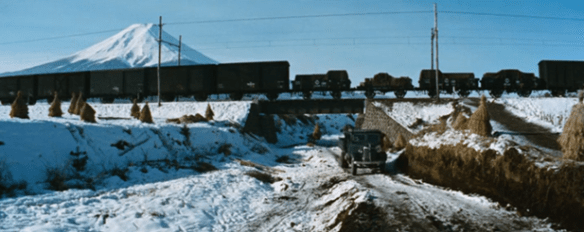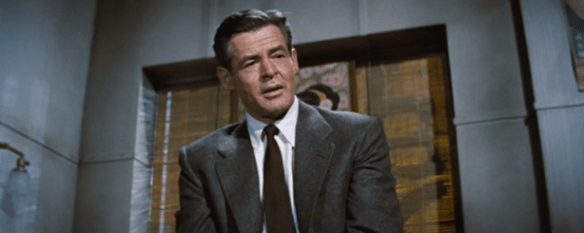
Leave it to Sam Fuller to make a film such as this — the first Hollywood film to be shot fully on location in Japan. His admiration for Japanese culture is not unheralded, specifically making something of a point to portray Japanese-Americans in pictures such as The Steel Helmet (1951) and The Crimson Kimono (1959).
And yet his style and sense of gritty bravado do at times feel out of place here as do the Hakujin military men milling about on Japanese soil. But even if his cultural awareness is not impeccable, I can’t help but feel that out of anyone who might have directed this movie, I’m somehow glad it was Fuller. It is far more than its title might suggest.
Shot in CinemaScope with DeLuxe Color, its sumptuous widescreen photography is put on display even in the opening shot as we are given a gloriously panoramic exterior of Mt. Fuji with a train loaded with military arms. It’s subsequently hijacked by marauders who escape unimpeded. With typical Fuller ferocity, we have our inroad to the film’s main conflict with a couple of men murdered. Soon after, a dying soldier implicated in the raid on his deathbed worries for his Japanese wife.
The dialogue is a bit terse and stodgy with the typical melodramatic setups which nevertheless condense action and exposition into bite-sized chunks as the police begin a joint investigation conducted by Inspector Kitz (Sessue Hayakawa) and Captain Hanson (Brad Dexter).
Weeks later the dead man’s old war chum, Eddie Kenner (Robert Stack) comes to Japan on the proposition of some employment. With his friend dead he starts throwing his weight around to get answers. Kenner goes to a rooftop interrupting a traditional performance, having an exchange that’s the epitome of ignorant American pig-headedness.
There’s no attempt whatsoever to learn the Japanese language or culture. He expects them to rise to his terms and play by his rules because he lives life thinking that “America is A Number 1.” He blunders around stubbornly repeating “Mariko Nagoya” and then goes into subsequent establishes looking for the boss of each joint to rough them up. Of course, he’s more nuanced than he lets on but in these scenes, it’s as if Fuller has developed an amalgam of the stereotypical lug-head G.I.

All such roads lead to a big man named Sandy Dawson (Robert Ryan) who uses a pachinko racket to front much more lucrative and clandestine activities that soon prove of some interest to Eddie. With his buddy gone this is his chance at something good and he’s a perfect candidate with a military record spattered with various misdemeanors.
The picture feels like much less of a police procedural and more of Kenner’s story as his relationship with Mariko (Shirley Yamaguchi) evolves and he must navigate the cutthroat tension that runs through such a high stakes operation like Dawson’s. Of course, it’s nerve-wracking for Kenner for another reason as well.
Our finale finds us at a rooftop kiddie amusement park that has Fuller’s usual flare for taking the utterly pedestrian and imbuing it with certain peril as Ryan frantically fights for survival on a revolving carnival ride. I’d expect nothing less from the writer-director.
A brightly textured post-war Japan is captured in full here. Though no overt commentary is made, it’s right there in front of us to draw our own conclusions. At times, the frames are vibrant with a world that looks to be thriving thanks to Yankee know-how and western influence. Truthfully, Fuller’s picture doesn’t show much of what the war’s aftermath may have done. We must infer that for ourselves. Because House of Bamboo is where the lush DeLuxe tones and the specters of film noir must meet.
As I gather, there is a certain mentality, a term that can be used that explains why this depiction is not so much a lie or a double standard but a definite reflection of the Japanese people.”Shō ga nai” (しょうがない) roughly means that something cannot be helped or whatever will be will be as the French would say. And so far from holding grudges, they were a people who looked at the war years under extenuating circumstances. Thus, afterward, though some might have harbored ill-feelings, there’s this sense that the U.S. could quickly become allies with Japan. That’s partially how it happened.
So when we see The Tokyo Police Department and The U.S. Military police working in perfect tandem and even the fact that this film production pays its respects to the local powers that be, it speaks to this same mutual symbiosis.
However, that certain amount of camaraderie doesn’t mean that there aren’t still major incongruities and differences. The choice to not use subtitles on the interludes spoken in Japanese is refreshing. Because like Crimson Kimono (1959) a few years later, it’s easy to presume that the picture might be promoting stereotypes and a certain point of view.

It’s true that Shirley Yamaguchi takes on a fairly stereotypical and unquestionably subservient role. Girls are flippantly referred to as commodities; the synecdoche of choice is “Kimonos.” I cannot deny that. And men such as Sandy and Eddie think they can stiff arm their way around the culture, straightening rough edges by handing out cigars as recompense. This doesn’t belay the fact that they are still fish-out-of-water. Not everything can immediately be made American nor should it.
Certainly it’s an imperfect picture and problematic for potentially perpetuating some common representations. However, whether or not he meant to, I think Fuller has provided us with a valuable portrait. It’s far from being as progressive as The Crimson Kimono but scouring it you see the inherent flaws with America trying to have their hands in rehabilitating Japan. At its core is something honorable but that doesn’t mean it comes off perfectly.
Sure, Japan has had its share of homegrown crime and problems born from within. But if you look at this picture everyone who is corrupt is a foreigner. It’s a dirty strain of capitalism where Sandy and his boys have muscled their way in, to the detriment of many of the Japanese.
Formally a casualty of pan and scan television techniques, this is no longer the case with House of Bamboo which has been restored to its full glory thank goodness. You can now catch Deforest Kelley for a few moments and relish a hard-nosed performance from Robert Stack opposite an unprecedented charismatic showcase for Robert Ryan.
If anything, as Eddie begins to genuinely fall for Mariko, there are affectionate touches that show that whether or not his initial behavior was a put on, he’s gradually revealing another side of himself. It means showing an interest in someone else’s culture. Doing the small things like using chopsticks to eat your meal or asking your girl how to say “Good night” in Japanese. For the record, it’s Oyasumi nasai (おやすみなさい).
More than anything else’s it’s a reminder that ignorance and entitlement can be rewritten and reformed when we genuinely care about other people. It stretches across cultural boundaries that we might come to understand others more personally. We need that kind of mutual understanding now more than ever.
4/5 Stars

Pingback: Sayonara (1957): Marlon Brando and Miiko Taka | 4 Star Films